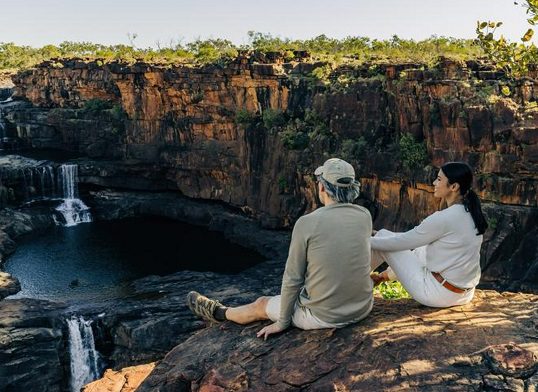 Among Aussie holidayers planning their 2023 winter escape from June onwards, a proportion will likely be heading overseas for the first time in three years. With the King’s Birthday weekend approaching, many Australians are also likely planning a domestic holiday. A survey has revealed a ranking of the top domestic and global travel destinations Aussies are likely to seek out for a holiday this year. By a significant margin, Queensland tops the list domestically whilst New Zealand tops the international list.
Among Aussie holidayers planning their 2023 winter escape from June onwards, a proportion will likely be heading overseas for the first time in three years. With the King’s Birthday weekend approaching, many Australians are also likely planning a domestic holiday. A survey has revealed a ranking of the top domestic and global travel destinations Aussies are likely to seek out for a holiday this year. By a significant margin, Queensland tops the list domestically whilst New Zealand tops the international list.
The findings were derived from a survey of an independent panel of 1001 Australian travellers, commissioned by leading, award-winning travel insurance provier InsureandGo.
98% of Aussies are travelling domestically or internationally this year
The good news is that nearly all respondents indicated they have, or will, take a holiday this year. Nearly two-thirds (61 per cent) are travelling inside Australia, while 37 per cent have gone or will travel overseas. Only 2 per cent are taking this year off travel.
Queensland tops the domestic holiday list, while the ACT ranks last
InsureandGo asked respondents to choose the most appealing State for a domestic holiday. One in three (35 per cent) chose Queensland. This comes as no surprise after Queensland saw a record $24.5 billion in domestic visitor spend in the year to September 2022, even after the international border re-opened. In December 2022, Premier Annastacia Palaszczuk said, “Queensland continues to be Australia’s shining light for domestic tourism.”
The InsureandGo survey found that only 16 per cent of respondents indicated NSW appealed to them the most, followed closely by Western Australia (chosen by 13 per cent). Victoria appealed to 12 per cent of respondents, while 11 per cent chose Tasmania, 7 per cent South Australia, 5 per cent the Northern Territory and just 1 per cent the ACT.
NZ tops the global list
Respondents were also asked to choose their top three global holiday destinations, for the year. Australia was included in the list, to measure its popularity as a holiday destination against well-loved global locations. Destinations closer to home came out on top as flight prices remain high and many travellers are still only beginning to re-introduce international travel to their holidays. In 2022, travel search engine KAYAK reported that average return economy international flight prices had soared by 33 per cent from 2019, as domestic prices continuing to remain above pre-pandemic levels in 2023.
The InsureandGo survey found that this year, trips to Asia and North America may eclipse the traditional European trip in the Aussie winter: The Asia-Pacific appealed to 44 per cent of respondents, whilst 35 per cent chose North America as their international destinations this year, compared with 31 per cent that chose Western Europe. The results showed:
- New Zealand (59 per cent).
- Asia-Pacific: East Asia, South Asia, Southeast Asia, and the Pacific Islands, (44 per cent).
- The USA and Canada (35 per cent).
- Western Europe (31 per cent).
- The UK (30 per cent).
- Eastern Europe (17 per cent).
- South America (8 per cent).
- Africa (6 per cent).
- Middle East/West Asia (5 per cent).
- Central Asia (5 per cent).
- Central America (5 per cent).
More than half (56 per cent) of respondents revealed that Australia appealed to them more than all of the international destinations listed in the survey for a holiday in 2023.
In a comparison of respondents across the major states and territories, the highest proportion of respondents that chose Australia as the top destination were from South Australia, at 61 per cent. This was followed by 59 per cent of West Australians, an equal 55 per cent of Queenslanders and Victorians, 54 per cent of NSW residents and 47 per cent of ACT residents who also viewed Australia as a top travel destination across the world.
What type of holiday are Aussies looking for this year?
InsureandGo also asked respondents to identify the three types of holidays that most appealed to them, from a list of 10. Beach holidays topped the list – chosen by more than three-quarters (76 per cent) of respondents – followed by city trips (chosen by 59 per cent). Cruises also ranked highly, attracting 34 per cent of respondents, while adventure holidays appealed to 32 per cent, and 26 per cent chose outback holidays. Smaller proportions of respondents were drawn to farm stays (19 per cent); family holidays at theme parks (16 per cent); camping and hiking (16 per cent); ski trips (11 per cent); and fishing trips (11 per cent).
Lower-income households are more likely to embark on a cruise holiday this year than higher-income households. This type of holiday was chosen by 37 per cent of respondents whose households earn ups to $60,000, compared with 35 per cent who earn between $60,000-79,999, and 31 per cent of those making over $80,000.
Kids’ theme park holidays are more popular with higher-income households (chosen by 21 per cent of respondents making over $100,000), compared with 14 per cent of those making $60,000-$90,000 and 12 per cent of households making up to $60,000.
InsureandGo spokesperson and Chief Commercial Officer Jonathan Etkind says, “It’s encouraging to see an overwhelming majority of Australians are still valuing travel as a great escape for their wellbeing, despite tightening of many household budgets in recent months.”
He further added, “While more than half of travellers are prioritising lower-cost holidays closer to home – either within Australia or to New Zealand – Australians should remember to purchase travel insurance for their domestic or international holidays. The cost of travel insurance is a small amount compared with the potential expenses incurred if something were to go wrong. Travel insurance can help safeguard finances from unexpected costs occurring from lost or stolen belongings, or an accident or illness prior to travel that requires cancellation of the holiday.”
InsureandGo has provided a list of considerations and general factors for Australians to consider to help them choose the right travel insurance cover:
- Destinations. Ensure all your destinations are covered by your insurance. This should include any destinations you choose to stop over at (even for just one night) and any places that you stop at on a cruise or tour.
- Medical. Understand how much coverage the policy gives you and under what circumstances the medical cover applies. If you have a pre-existing medical condition, you’ll need to confirm that this doesn’t exclude you from the cover you want. Know the insurance excess you will be required to pay before your medical cover kicks in.
- Personal belongings. Most travel insurance policies should provide some level of cover for personal belongings. The difference between policies is how much you are covered for and if that sum adequately covers all your belongings. If not, you may want to change your policy or consider upgrading to include specific items.
- Valuables. You should never assume that any valuables will be automatically covered by your insurance policy. Common items such as passports, phones, laptops, cameras, tablets, sunglasses and jewellery are often excluded from cover, particularly on low-level or basic policies. Make sure you read the insurer’s product disclosure statement to gain an understanding of whether your valuables are protected and under what circumstances you can make a claim.
- Sports and activities. If you expect to participate in sports and activities that could risk injury or illness – particularly high-risk activities such as motorcycling or white-water rafting – ensure your insurance will cover you in those circumstances. Check in the product disclosure statement that these activities are specifically named, and the terms and conditions around their application. For instance, if you are scuba diving, you may only be covered to a certain depth.
- Cancellations. Things don’t always go according to plan, and there may be some unexpected events that require you to cancel your trip. If you do, you’ll need to check that cancellation is part of your travel insurance policy. If you have the right cover, you may be able to claim lost funds from cancelled flights, accommodation, car hire, tour bookings and more. Your policy should tell you the maximum amount of money that you can claim.
- Limits/excesses. Most insurance policies include excesses for claims – such as a $100 excess for a lost baggage claim. If you want to keep your excess low, consider purchasing a higher level of cover or choose to waive the excess altogether by paying a higher premium.
- Exclusions. Read the product disclosure statement to understand what is excluded from your cover. Make note of specific events or items that are excluded, as well as any circumstances or situations that automatically mean your losses will be excluded.
A summary of the survey results is as follows:
| Are you planning to travel in 2023? | % of respondents* |
| Yes, travel within Australia | 61 |
| Yes, travel overseas | 37 |
| No | 2 |
| Which Australian State or Territory most appeals to you for a 2023 holiday? | % of respondents* |
| NSW | 16 |
| Victoria | 12 |
| Queensland | 35 |
| Western Australia | 13 |
| South Australia | 7 |
| Northern Territory | 5 |
| ACT | 1 |
| Tasmania | 11 |
| Which global country or region appeals to you for a 2023 holiday? | % of respondents* |
| Australia | 56 |
| New Zealand | 59 |
| Western Europe | 31 |
| Eastern Europe | 17 |
| UK | 30 |
| South America | 8 |
| USA and/or Canada | 35 |
| Central America, such as Mexico | 5 |
| Asia-Pacific, i.e. East Asia, South Asia, Southeast Asia, Pacific Islands | 44 |
| Middle East / West Asia | 5 |
| Central Asia, such as Tibet | 5 |
| Africa | 6 |
| What type of holiday appeals to you? | % of respondents* |
| Skiing | 11 |
| Beach | 76 |
| City | 59 |
| Farm stay | 19 |
| Outback | 26 |
| Kids’ theme park | 16 |
| Fishing | 11 |
| Cruise | 34 |
| Adventure | 32 |
| Camping/hiking | 16 |
















